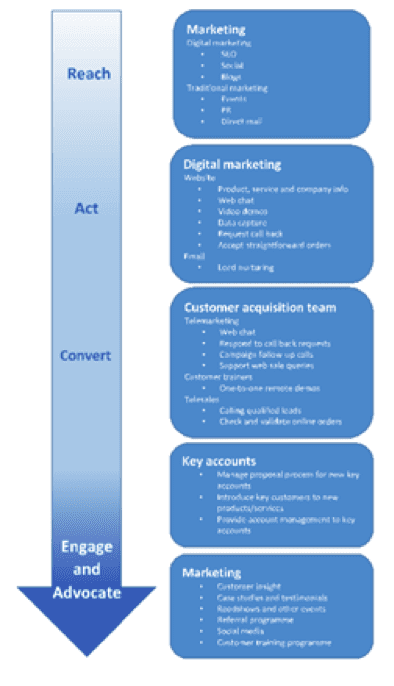How to avoid the common pitfalls of B2B marketing campaigns
As a marketer with practical experience within the B2B space as well as working as a trainer, teaching a number of digital marketing subjects, means I have direct access to marketers and business owners. I've noticed a number of issues and themes have appeared quite frequently over the last 12 to 18 months. When coming up with the 10 mistakes for this guide I brainstormed with Dave and his team and it was a much wider list!
We boiled down to 10 themes that I have explored in detail, giving you some background into what they are and examples which you may sympathize with or are currently experiencing. The advice to tackle these issues includes a mini do to list to help shape your actions plans, and it goes without saying that there are more practical and detailed resources within the Smart Insights ecosystem of content.
Although the focus for this guide has been B2B, any marketers can get something out of this 10 mistakes guide.
1. Thinking that user experience is just for web and dev
If I'm honest, even though I totally agreed with the principles of user experience the 1st time I studied it back in 2008, and I loved Steve Krug’s book “Don't make me think”, I’ve read Jakob Nielsen “Web Usability”, and I’ve used user flows and use cases for my web personas.
However, post website projects I've left user experience alone.
What a mistake that was.
If you really want to succeed and provide products and services and market them in a way that's really going to connect with your prospects you need to get into this. It will make you more money, I promise.
Usability means making sure something works well and that a person of little experience can use it for its intended purpose without getting hopelessly frustrated.
The key fundamentals of good UX is to:
1- Identify the user needs. This comes from having a deep understand of your customers which take shape in the form of personas and customer empathy maps.
2- Understanding your business goals. You should have clear KPI's and map back to an objective first approach for all your campaigns and activities
3- Technical constraints. Does it Better will always beat Did it First.
Set up your personas with a customer empathy map to dig deeper into your prospects and customers and do some UX testing.
B2B marketing generally has a longer process and sales cycle than you find in B2C and you must have a good understanding of your decision-making unit and how they go about finding information on your products and services.If you have a persona drawn up, use them. I still see marketing teams that create a persona, tick a box in their head, and carry on as they did before.

To punch up your personas a notch and really embrace UX, you need to create a customer empathy map for your personas.
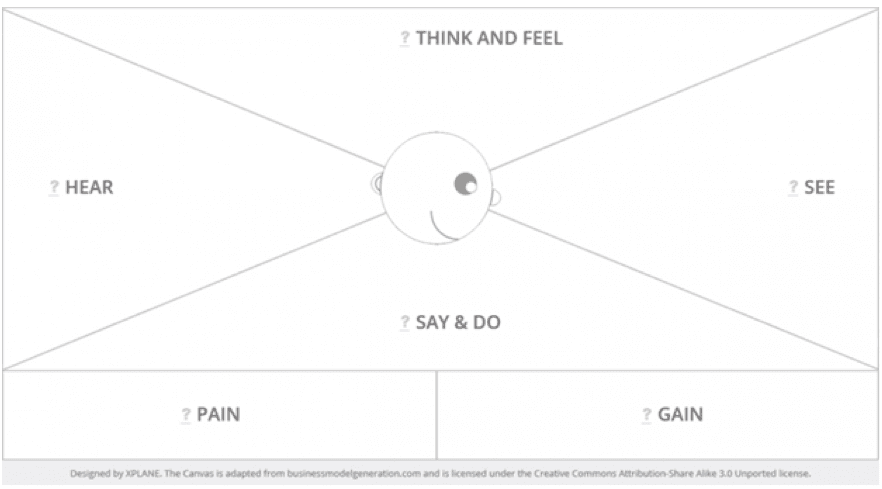
The empathy map has 6 different components:
- How the customer thinks and feels
- What the customer hears
- What the customer sees
- What the customer says and does
- The customer’s pain
- The customer’s gain
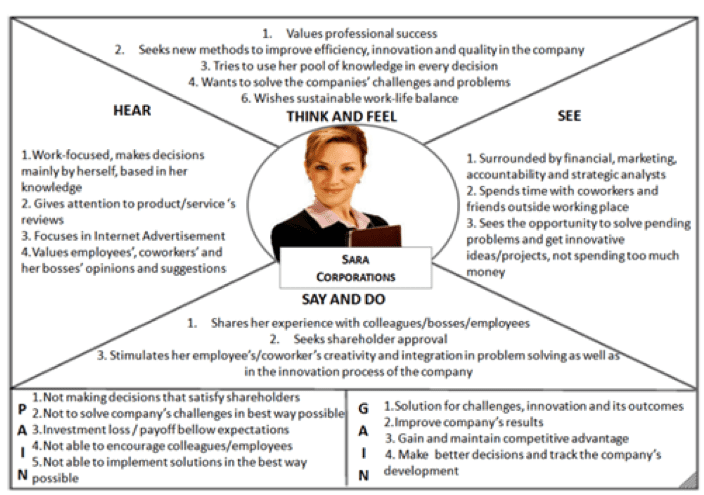
A customer empathy map can improve your marketing. It can help you understand what keywords would be a better fit for your SEM, what content works, should you be doing paid social etc. otherwise you are just guessing.
It has become a lot more affordable to do UX test, you can get 10 videos of tests from whatusersdo.com for £300 and add filter questions to who gets the test so your matching to your target audiences.
Usabilityhub.com can give you insights on things like your navigation, or click tests for your latest DM campaign or landing page, responses start at $1 per response. $1! Cheap as chips.
Does it work?
I asked Timi Olotu, Senior Writer & Content Strategist for What Users Do, he shared a case study from Pan Macmillian, they increased click throughs to book retailers by 400% after watching user tests struggle with completing their business goals.
“It’s amazing the things we can overlook when we become acclimatised to our own sites or lack the mindset of a user genuinely in need of a solution. For example, Pan Macmillan – one of the world’s largest publishers and B2B businesses – increased click-through to book retailers by 400%, simply by adding a ‘Buy' button next to book descriptions. The company never had these because the site was traditionally considered to be an ‘online catalogue’. But having watched UX testing videos of how people actually use its site, the Pan Macmillan team realised a ‘Buy’ button would not only be great for users, it would also be great for business.”
2. Not setting up your Analytics to correctly track your leads
This is a very deep subject, but for this guide so I just focused on some of the common issues I have seen with the B2B analytics accounts that you should be giving some attention to.
One of them is not having goals set up on your website.
I do a lot of analytics audits, and teach analytics in a monthly workshop for General Assembly, so I get to see a lot of analytics accounts. From my experience, around 40% of the accounts I see do not have any goals set up on their accounts. This is more down to not understanding how to set up analytics to create the goals. For example, if a goal for you is to submit a form, but that form does not have a destination URL , you need to set up event tracking, and with that, create an event goal. I always say “you don’t know what you don’t know” so don’t kick yourself. Just learn it, and fix it.
Access free Member resource – 10 business to business mistakes guide
This detailed free guide takes you through useful strategies to avoid the 10 most common B2B mistakes..
Access the 10 Business-to-business marketing mistakes
You cannot expect anyone to put value on our marketing efforts if you are not able to track and attribute what you are doing. For me, this is a vital part of marketing.
I like to map out the flow of the business through their funnel, from top to bottom, and check what tracking solution they need (based on their website configuration). This is a worthy exercise to do as you may find that you’re not tracking everything correctly for you to understand and find a solution to the questions you are trying to answer.
For example, you have a lot of video content assets and you want to know if they help people convert for a free trial, therefore a micro goal would be ‘watched a video’. So, in your analytics audit you need to check and set up event tracking on your website to see this data.
| RACE | Macro and Micro Goals | Type of tracking needed | In place ?
Yes / No |
| Reach | Scroll Reach | Event | N |
| Act | Read Blog / case study
Watch Video
Watch Webinar
Social Share
Live Chat
CTA clicks | Standard Reporting
Event (YT script GTM)
Event
Event
Event
Event | Y
N
N
N
Y
Y |
| Convert | Lead gen- form for content
Request Free Video
One Month Trial
Create Account
Watch Video (how to get started)
Contact form (enterprise accounts) | Event
Event
Event
Destination
Event
Destination | Y
Y
Y
Y
N
Y |
| Engage | Log into SaaS account | Event | N |
In the guide, I talk about Event Tracking, Segmentation, Custom Dimensions and Data Import, so download and have a read!
3. Not testing improvements
“We don’t use A/B tests to pick winners. We use them to avoid losers as we stack confirmed winners”. @growthtactics
When you have FREE tools like Googles Optimize, Convert.com or Optimizely for your website, and nearly all campaign programs from Adwords to email have FREE options to test, and people are STILL not doing it. A few small changes is all it can take to make your marketing efforts go further. We all have a leaky bucket, wouldn't it be nice to understand what is stopping people from converting?
AB testing is not just for ecommerce testing to see if a man holding the shoe gets more people to convert that a woman holding the shoe. You should be testing everything, all the time. Make it a company culture.
You can test anything, and you can make an impact just playing around with words. Don't believe me, here are some A/B tests I did for a hotel company targeting B2B bookings. If we used the word star instead of using an asterisk I got more sales, it was a simple as that.

When it comes to testing, it can be easy to get lost in the sheer volume of “where the hell do I start”
I am a big fan of Widerfunnels PIE framework, as it really helps you to understand where you should be focusing your attention.
You need to rank each page with a score out of 10 over these 3 areas.
- Potential – How much potential for a conversion rate increase does this testing opportunity have?
- Importance – How important is this page? How many visitors will be impacted from the test? What is the traffic volume? What is the cost of the traffic? What is the quality of the traffic? What is the impact on ROI?
- Ease – How easy is it to test on the identified page? What are the barriers, both technical and political, to testing that surround this page.
This gives you your test order.
Download the guide to find out how to create a good hypothesis and see a CRO case study in action.
4. Buying technology and not knowing how you will use it
Sales using one CRM, Marketing using a Marketing Automation tool, both not talking to each other and thinking that some new tech-tool is the magic wand to make things better. It isn’t. You need processes, you need procedures, you need data and content in place for it to work. I have spoken to a few marketing managers recently who are spending time doing admin to add more detail to the database which is just an email address and sometimes a name.
There are loads of cool tech solutions to make our marketing pop. However, if you jump in and buy the technology before you know how you will use it, and how it will fit into your current ecosystem, you can waste money, and actually hinder your sales. The tech works but with no data, it is just an expensive place to hold your mailing list.
I had a good chat about this topic with John Odam-Adjei, founder of Medasi, he has worked for large, multinational technology-oriented transformation projects for large multinational companies and now helps startups and established SMEs take advantage of cloud technologies to better engage customers, reduce their costs and increase profits. To do more with less, if you will.
“It’s really important to have a roadmap when deploying a new solution such as CRM. It doesn’t have to be complex at the start – that tends to happen anyway as the project unfolds. A roadmap is a good tool to hang, discuss and structure ideas for how the new business processes and tools will impact the business. From there, you can craft a project plan to get the outcomes you need.
Download the guide to get the 6 steps to creating a road map.
5. Content Mapping: Aligning content assets to the Sales Funnel
“We are thinking about content marketing as campaigns, we need to do better. 9/10 marketers are doing some content marketing, 50% don’t have a strategy or know what success looks like. On average only 30% of content is effective” Joe Pulizzi, Content Marketing Institute.
You know the drill, create original, relevant content that mirrors your personas pain points, use it to communicate a message to your audience and hope to drive a profitable customer interaction. Blahblahblah.
Content is a meaty subject, and needs to have a defined strategy, you NEED content! It feeds your website, your email programs, your social comms, everything. After you have defined your personas, and worked on your pain points, content themes, and objectives with clear and solid KPIs, I always do an audit.
I see people with an editorial calendar and they think that that is their content strategy. You need to audit your content to the funnel. Why? See what you are missing. I see clients either have too much at the front or back, and they never repurpose. That white paper you want people to download on twitter. That should be an intro to a blog post and a click to email the pdf to your desk which is a better UX and makes your content efforts go further.

6. Using social media as a billboard
"View social media as a two way medium. You have to offer something interesting or valuable in order to garner engagement. Simply broadcasting your offers will put people off. Think immersive store experience vs market trader”. Andrew White, Media Solutions Consultant, Linkedin
Social Media is supposed to be Social
I think there are a lot of brands, that see social media as a channel to broadcast their marketing messages. Personally, I think that we have become a little jaded and don’t ‘trust’ brands and their social content, and some brands struggle to have a unified and authentic brand voice on social media.
If a brand is using social as a broadcast channel, then that brand voice will never be heard. You need to understand your audience, how they use social media, and max this out with empathy. This is hard to do as you may need to let go of some of the control and be media neutral putting yourself in the shoes of your customers.
B2B brands that do social really well.
Intel on Facebook to celebrate the diversity of its own engineers. It called attention to the strength of Intel’s corporate culture and surely went a long way toward helping its recruitment efforts.

Oracle used Twitter to really show their 440,000 followers its philanthropy side, gives prospects, customers, and potential staff a chance to see a softer side to the brand.
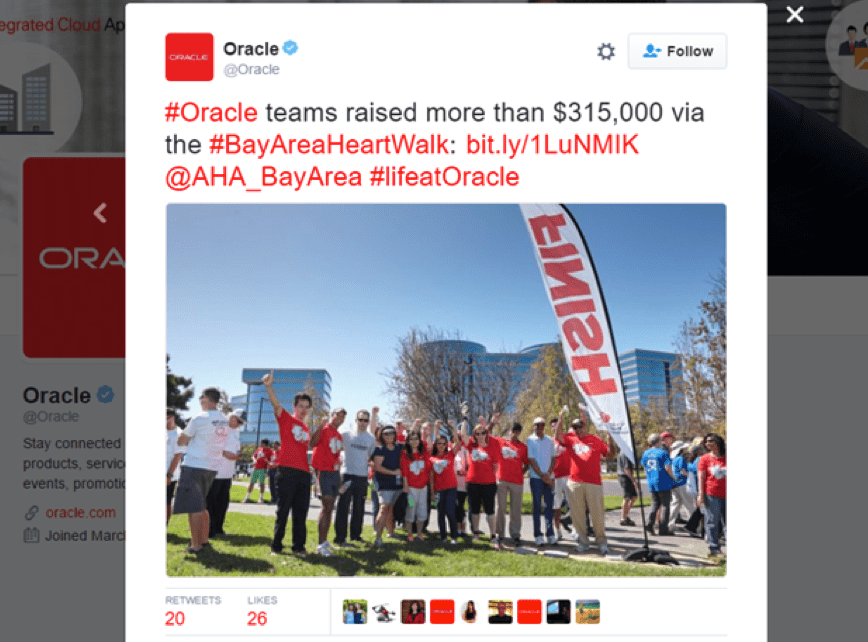
7. Not cleaning your database
Hands up. Who has a data strategy?
It is not the most glam of all marketing tasks, but your data is the blood that runs through your marketing body, and your blood may be a little toxic. Having a data strategy and process of how you manage data will keep your blood flow moving in the right direction.
You have all heard the phrase that B2B data decays faster than B2C, around 25% of your data, on average, will be dead in a year, job moves and changes, that sort of thing, yet you will still meet businesses that have NEVER cleaned their data.
Data is just a proxy for people and the truth is, you can not do email, CRM, Direct Marketing campaigns to your prospects and customers if your data is poor.
Crap in, crap out.
The term dirty data was created for a reason, and you should be scared by it. But what to do? The first step to recovery is to define a data strategy.
Step 1- Do an audit
Step 2- De dupe
Step 3 – Check and honor preferences
Step 4- Enrich your dataset.
Step 5 -Write as formal document
Download the guide to find out what is involved in each step of a data audit.
8. Not following best practices in Organic or Paid Search
Search is a high intent channel, people head over to Google and are actively looking for information, you may have the best product, super smart website, but if no one can find you, you don’t catch any fish and will go hungry.
PPC
2016 saw quite a large change to Adwords in the form of expanded text ads. You have until January 2017 to edit all of your PPC adverts before they roll over to the new format. Previously we had headlines of up to 30 characters, a single description of up to 80 characters. Now you have almost a 50% increase in the amount of space for your adverts.
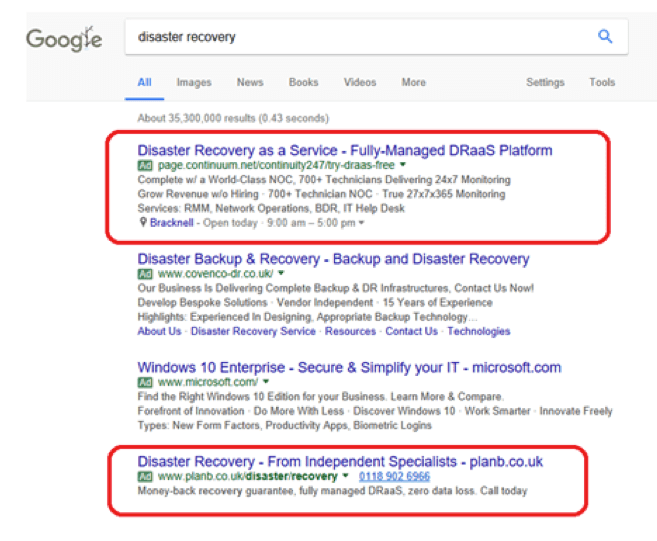
Do an audit and tweak your ads also check for ad extensions and site links, You can use site links to drive people to different pages on your website, you can use call out extensions for specific value proposition messages, you can have all localization extensions to show where your business is located, what time you open till etc.
Remarketing
I am a big fan of remarketing, actually let me rephrase that, I am a big fan of people that don't do sloppy remarketing. I am referring to the business that follow me around the web like a little lost puppy based on the notion that I came to your website and didn't convert your big-hitting-we-are- going-to-die macro conversion……. so they stalk me. What's worse is when I actually convert and fill out your damn form or buy your products and services, you still follow me around the web.
You can build very clever bespoke remarketing lists based on the actions of your users on your website by creating segments and using these to build your remarketing lists.
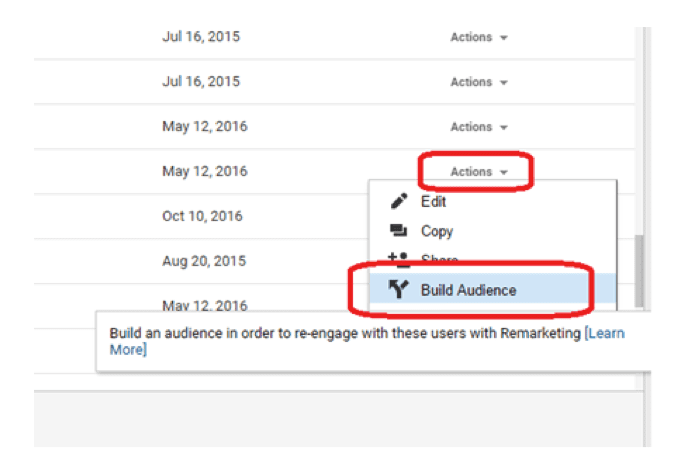
Organic
I've always believed that as long as you adhering to Google best practice guidelines in creating and setting up your web site and you're producing valuable relevant content that people want to read and the people want to link to, then you're all good. There is a tool called Screaming Frog which is free to use and it will pull all of your web pages, the title tags, alt tags, meta descriptions, keywords for you to export as an Excel document for you to audit and tidy up your house.
“Only 3% of searches have the classic 10 blue links” Rand Fishkin, MozCon 2016
3% of searches show 10 blue links, I had to reread it, and what do we all ask for? ‘Hi SEO team, can I rank #1 for this page……” Download the guide to read how to use keyword research to improve your organic reach and find opportunities to rank within the SERP features.
9. Care sales copy
Yes, it is b2b, but that does not equal boring, b2b is personable there is a human emotional element as well as rational. You can have fun, you can improve your writing with storytelling, you can make better use of your email campaigns without making it all about the sale.
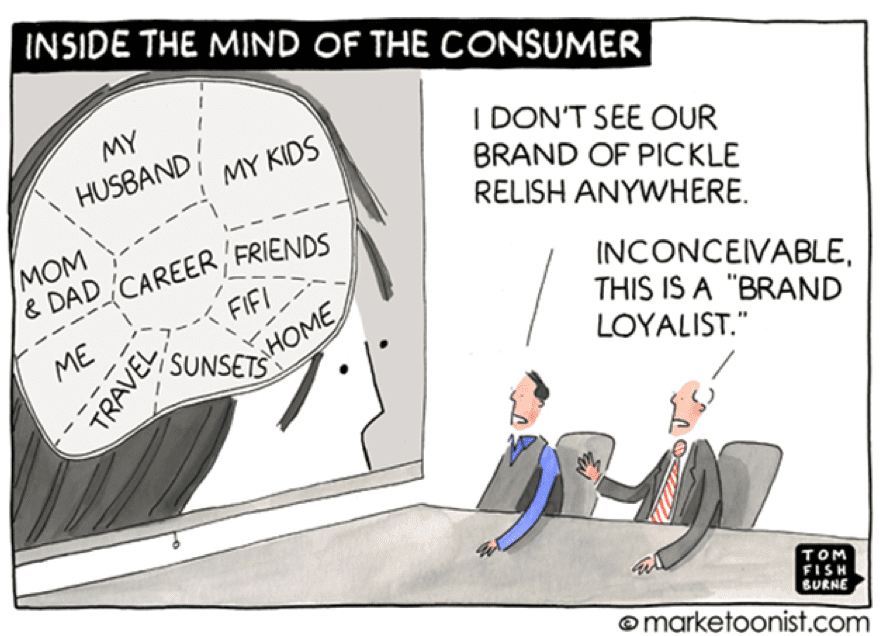
The problem with this is that your customers really don't want to listen to all the wonderful features and benefits of your products and services they just don't care enough. You need to bring storytelling to the table and inspire people to behave differently.
DropBox is a great example of using storytelling to connect to an audience, because the truth is your customers will relate better to the story if it can identify with the characters or personalities within. Drew Houston the founder of Dropbox could have just started with the story of “we have invented a file hosting system offering a personal cloud as a service”. Back in 2007 people didn't really understand what a cloud was, the FAB message didn't stick. So instead he opted to start with a story that his target prospects could identify with and that story started by reminding people about the frustration of leaving behind USB sticks or being given a USB stick which might have made you worry about getting a nasty virus on your laptop and then he started talking about Dropbox .
How do you write customer centric converting copy? Yep, you guessed it, dowload to the guide for the tips.
10-Not aligning Sales and Marketing
Small or large , there is always some silo behaviour between work streams, but for us all to get along and achieve the same company wide objectives you need to work together. Sales and marketing need to align, agree on what a MQL is and when to hand over to sales, what is the user flow for that.
Could you have a service level agreement between the two departments and work together to master the technology you are using to manage your prospects and customers.
Could you have a service level agreement between the two departments and work together to master the technology you are using to manage your prospects and customers?
Your SLA document aims at providing mutual accountability by agreeing project plans and responsibilities together at the start of any marketing programs or campaigns through to what sales intend to do with leads when they get their hands on them.
Ideas for your SLA:
- Quotas: how many leads do marketing need to deliver to sales over a set period.
- Define what a lead is: all data is not equal, therefore not all leads are created equal. Agree with sales what a qualified lead looks like and either set this up in your automation system or take a spreadsheet approach.
- Timescales for follow-up – agree what the follow-up will look like and within what time scales this will be completed. Do prospects get a welcome email as soon as they fill out a form, when will someone call if they request a call back?
Map strategy and tactics to RACE to visualize activity to achieve goals together. I have found this very powerful for the whole company to see how each cog turns the wheel, and to expand on this and identify how marketing is going to find customers, how they will manage the leads, and when they hand over to sales.
